Blog & Latest Updates
Fly Fishing Articles
Insects by Common Name


Animal Phylum Arthropoda (Arthropods)
Taxonomic Navigation -?-
Kingdom
Animalia (Animals)
» Phylum Arthropoda (Arthropods)
| Class in Arthropoda | ||
| ArachnidaMites and Spiders | 0 | 1 |
| CollembolaSpringtails | 0 | 0 |
| Crustacea-MalacostracaCrayfish, Scuds, and Sowbugs | 0 | 10 |
| Crustacea-Maxillopoda | 0 | 0 |
| InsectaInsects | 0 | 114 |
Common Name
| Match | Common Name |
| Arthropods |
This is page 99 of specimens of Arthropoda. Visit the main Arthropoda page for:
- The behavior and habitat of Arthropoda.
- 122 underwater pictures of Arthropoda.
Pictures of 1244 Arthropod Specimens:
Female Epeorus vitreus (Sulphur) Mayfly Spinner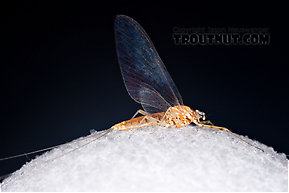 View 4 Pictures
View 4 Pictures
 View 4 Pictures
View 4 PicturesCollected May 28, 2007 from Mystery Creek #42 in Pennsylvania
Added to Troutnut.com by Troutnut on June 4, 2007
Added to Troutnut.com by Troutnut on June 4, 2007
Female Siphlonurus occidentalis (Gray Drake) Mayfly Spinner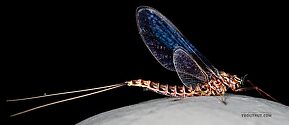 View 9 Pictures
View 9 Pictures
 View 9 Pictures
View 9 PicturesCollected July 31, 2020 from the Henry's Fork of the Snake River in Idaho
Added to Troutnut.com by Troutnut on August 16, 2020
Added to Troutnut.com by Troutnut on August 16, 2020
Female Baetidae (Blue-Winged Olives) Mayfly Dun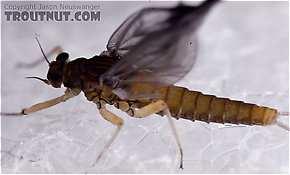 View 4 Pictures
View 4 Pictures
 View 4 Pictures
View 4 PicturesCollected May 29, 2007 from Paradise Creek in Pennsylvania
Added to Troutnut.com by Troutnut on June 4, 2007
Added to Troutnut.com by Troutnut on June 4, 2007
Ephemerella aurivillii Mayfly Nymph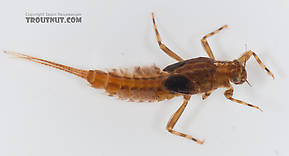 View 5 PicturesThis nymph hatched out in my aquarium into this dun.
View 5 PicturesThis nymph hatched out in my aquarium into this dun.
 View 5 PicturesThis nymph hatched out in my aquarium into this dun.
View 5 PicturesThis nymph hatched out in my aquarium into this dun.Drunella grandis (Western Green Drake) Mayfly Nymph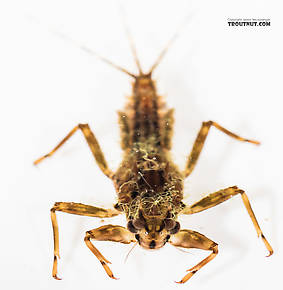 View 10 Pictures
View 10 Pictures
 View 10 Pictures
View 10 PicturesCollected June 16, 2018 from the South Fork Snoqualmie River in Washington
Added to Troutnut.com by Troutnut on June 18, 2018
Added to Troutnut.com by Troutnut on June 18, 2018
Female Cinygmula ramaleyi (Small Western Gordon Quill) Mayfly Spinner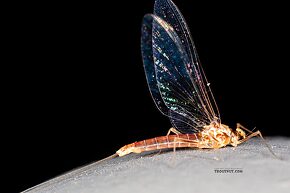 View 7 Pictures
View 7 Pictures
 View 7 Pictures
View 7 PicturesCollected August 3, 2020 from Star Hope Creek in Idaho
Added to Troutnut.com by Troutnut on August 19, 2020
Added to Troutnut.com by Troutnut on August 19, 2020
Male Callibaetis (Speckled Spinners) Mayfly Spinner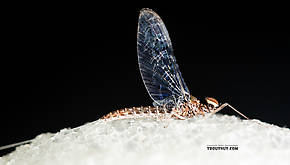 View 6 Pictures
View 6 Pictures
 View 6 Pictures
View 6 PicturesCollected August 11, 2018 from the Firehole River in Wyoming
Added to Troutnut.com by Troutnut on June 12, 2019
Added to Troutnut.com by Troutnut on June 12, 2019
Ameletus vernalis (Brown Dun) Mayfly Nymph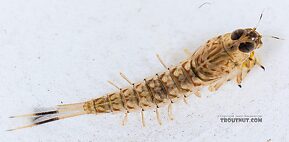 View 9 PicturesI keyed this one out using the Alberta species key from Zloty & Pritchard 1997.
View 9 PicturesI keyed this one out using the Alberta species key from Zloty & Pritchard 1997.
Notes from the ID include:
1. Posterior (Posterior: Toward the back of an organism's body. The phrase "posterior to" means "in back of.") margin of sternites (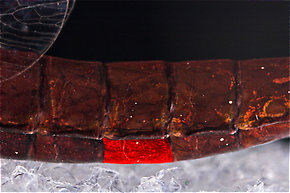 Sternite: The bottom (ventral) part of a single segment on an insect's abdomen.) 6-8 without spines
Sternite: The bottom (ventral) part of a single segment on an insect's abdomen.) 6-8 without spines
2. Mesal (Mesal: Toward the middle.) gill extension "well developed"
3. Basil third of caudal (Caudal: Toward the posterior tip of the body.) filaments pale
4. Anterior (Anterior: Toward the front of an organism's body. The phrase "anterior to" means "in front of.") surface of front femora (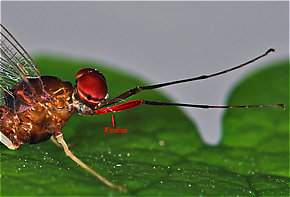 Femur: The main segment of an insect's leg close to the body, in between the tibia and the trochanter.) mostly pale
Femur: The main segment of an insect's leg close to the body, in between the tibia and the trochanter.) mostly pale
5. Dark band on caudal (Caudal: Toward the posterior tip of the body.) filaments begins around segment 20
6. Final instars (Instar: Many invertebrates molt through dozens of progressively larger and better-developed stages as they grow. Each of these stages is known as an instar. Hard-bodied nymphs typically molt through more instars than soft-bodied larvae.) early season
This one keys out pretty cleanly to Ameletus vernalis except the color pattern on the tergites (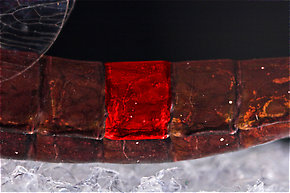 Tergite: The top (dorsal) part of a single segment on an insect's abdomen when it consists of a single chitinous plate (sclerite), or an individual sclerite if the segment has more than one.) doesn't match. However, two species known in Washington aren't included in the key. Of those two, Ameletus vancouverensis would be too small (adult body length 9 mm), but Ameletus andersoni (currently documented only from a spring in Cowlitz County) has a wide range of sizes and emergence times that could be compatible with this one. So I can't rule that species out, but Ameletus vernalis seems the most likely.
Tergite: The top (dorsal) part of a single segment on an insect's abdomen when it consists of a single chitinous plate (sclerite), or an individual sclerite if the segment has more than one.) doesn't match. However, two species known in Washington aren't included in the key. Of those two, Ameletus vancouverensis would be too small (adult body length 9 mm), but Ameletus andersoni (currently documented only from a spring in Cowlitz County) has a wide range of sizes and emergence times that could be compatible with this one. So I can't rule that species out, but Ameletus vernalis seems the most likely.
 View 9 PicturesI keyed this one out using the Alberta species key from Zloty & Pritchard 1997.
View 9 PicturesI keyed this one out using the Alberta species key from Zloty & Pritchard 1997. Notes from the ID include:
1. Posterior (Posterior: Toward the back of an organism's body. The phrase "posterior to" means "in back of.") margin of sternites (

One sternite of this Isonychia bicolor mayfly spinner is highlighted in red.
2. Mesal (Mesal: Toward the middle.) gill extension "well developed"
3. Basil third of caudal (Caudal: Toward the posterior tip of the body.) filaments pale
4. Anterior (Anterior: Toward the front of an organism's body. The phrase "anterior to" means "in front of.") surface of front femora (

The femur of this Isonychia bicolor mayfly spinner is highlighted in red.
5. Dark band on caudal (Caudal: Toward the posterior tip of the body.) filaments begins around segment 20
6. Final instars (Instar: Many invertebrates molt through dozens of progressively larger and better-developed stages as they grow. Each of these stages is known as an instar. Hard-bodied nymphs typically molt through more instars than soft-bodied larvae.) early season
This one keys out pretty cleanly to Ameletus vernalis except the color pattern on the tergites (

One tergite of this Isonychia bicolor mayfly spinner is highlighted in red.
Collected April 9, 2021 from the Yakima River in Washington
Added to Troutnut.com by Troutnut on April 12, 2021
Added to Troutnut.com by Troutnut on April 12, 2021
Female Baetidae (Blue-Winged Olives) Mayfly Dun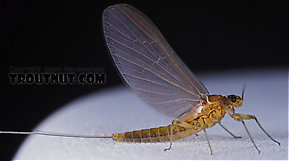 View 4 PicturesThis specimen was collected on the same trip as a similar dun.
View 4 PicturesThis specimen was collected on the same trip as a similar dun.
 View 4 PicturesThis specimen was collected on the same trip as a similar dun.
View 4 PicturesThis specimen was collected on the same trip as a similar dun.Collected May 28, 2005 from the Namekagon River in Wisconsin
Added to Troutnut.com by Troutnut on May 24, 2006
Added to Troutnut.com by Troutnut on May 24, 2006
Female Suwallia pallidula (Sallfly) Stonefly Adult View 9 PicturesI collected a few of these throughout the afternoon. The positive ID on the adults allowed me to also put a species ID on the nymphs.
View 9 PicturesI collected a few of these throughout the afternoon. The positive ID on the adults allowed me to also put a species ID on the nymphs.
 View 9 PicturesI collected a few of these throughout the afternoon. The positive ID on the adults allowed me to also put a species ID on the nymphs.
View 9 PicturesI collected a few of these throughout the afternoon. The positive ID on the adults allowed me to also put a species ID on the nymphs.Collected July 28, 2019 from Mystery Creek #199 in Washington
Added to Troutnut.com by Troutnut on July 29, 2019
Added to Troutnut.com by Troutnut on July 29, 2019
Top 10 Fly Hatches
Top Gift Shop Designs
Eat mayflies.
Top Insect Specimens
Miscellaneous Sites
Troutnut.com is copyright © 2004-2024 Jason
Neuswanger (email Jason). See my FAQ for information about use of my images.
 privacy policy
privacy policy
